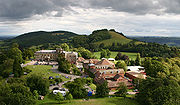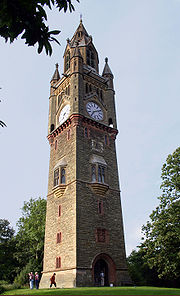
Abberley Hall
Encyclopedia

Worcestershire
Worcestershire is a non-metropolitan county, established in antiquity, located in the West Midlands region of England. For Eurostat purposes it is a NUTS 3 region and is one of three counties that comprise the "Herefordshire, Worcestershire and Warwickshire" NUTS 2 region...
, England. The present Italianate house is the work of Samuel Daukes
Samuel Daukes
Samuel Whitfield Daukes was an English architect. He was born in London in 1811, the son of Samuel Whitfield Daukes, a businessman with coal mining and brewery interests, who bought Diglis House, Worcester in 1827. He was articled about 1827 to James Pigott Pritchett of York, and had set himself...
and dates from 1846-49. Since 1916 it has been occupied by Abberley Hall School
Abberley Hall School
Abberley Hall School is a mixed private boarding school for around 300 pupils aged 2 to 13 with 38 full time and 25 part time teaching staff. About 100 of the pupils are full boarders. It is located in the village of Abberley about halfway between Worcester and Tenbury Wells in the...
. It is a Grade II* listed building. The gardens are listed as Grade II on the English Heritage
English Heritage
English Heritage . is an executive non-departmental public body of the British Government sponsored by the Department for Culture, Media and Sport...
Register of Parks and Gardens of Special Historic Interest in England
National Register of Historic Parks and Gardens
In England, the Register of Historic Parks and Gardens of special historic interest in England provides a listing and classification system for historic parks and gardens similar to that used for listed buildings. The register is managed by English Heritage under the provisions of the National...
.
History
Throughout the medieval period the estate on which Abberly Hall stands was a possession of the de Toeni family of Elmley CastleElmley Castle
Elmley Castle is a village and civil parish in Worcestershire, in England, United Kingdom. It is located on the north side of Bredon Hill 4 kilometres south east of Pershore in the local government district of Wychavon.- Amenities and history :...
, Worcestershire. A 'chief messuage' was mentioned in 1309, and Habington says that “Abberley seemethe to have byn of owld the principall seat of the Lord Thony in this shyre”. In the 1530s, Leland referred to a castle at Abberley, but there is no other evidence the house was more than a manor house. King Henry VIII
Henry VIII of England
Henry VIII was King of England from 21 April 1509 until his death. He was Lord, and later King, of Ireland, as well as continuing the nominal claim by the English monarchs to the Kingdom of France...
gave the estate to his page of the privy chamber, Sir William Walshe, in 1531, and the house descended in that family to William Walsh, the poet and critic (died 1708), from whom it passed by marriage to the Bromleys. Nothing is known of the house prior to the publication of a drawing in Dr. Treadway Russell Nash
Treadway Russell Nash
Treadway Russell Nash was English clergyman, now known as an early historian of Worcestershire, and the author of Collections for the History of Worcestershire, an important source document for Worcestershire county histories. He was a fellow of the Society of Antiquaries of London...
’s History of Worcestershire which shows a three-storey house with a five-bay centre, single-bay projecting wings, a prominent cupola, and a door with a broken segmental pediment. This may date from William Walsh’s ownership (1682-1708) or that of his successor, Francis Bromley (1708-c1740). An irregular wing suggests that the early 18th century appearance was due to the remodelling of the previous house rather than a new build. When Colonel Bromley died in the 1830s, leaving seven daughters and no son, his executors decided to sell the estate, which comprised less than 800 acres (3.2 km²) and was heavily encumbered by debts.
The old house was in very poor repair, and the purchaser in 1836, John Lewis Moilliet pulled it down and employed Samuel Daukes
Samuel Daukes
Samuel Whitfield Daukes was an English architect. He was born in London in 1811, the son of Samuel Whitfield Daukes, a businessman with coal mining and brewery interests, who bought Diglis House, Worcester in 1827. He was articled about 1827 to James Pigott Pritchett of York, and had set himself...
to build an Italianate replacement; this was Dawkes’ first major country house commission. Moilliet died in 1845 and that Christmas his new house burned down. Moilliet’s widow and son promptly employed Daukes to rebuild the house in 1846-49 on the old foundations and apparently to the original design. The house was extended and redecorated internally by J.P. St. Aubyn
James Piers St Aubyn
James Piers St Aubyn , often referred to as J. P. St Aubyn, was an English architect of the Victorian era, known for his church architecture and confident restorations.-Early life:...
for a later owner, John Joseph Jones, an Oldham
Oldham
Oldham is a large town in Greater Manchester, England. It lies amid the Pennines on elevated ground between the rivers Irk and Medlock, south-southeast of Rochdale, and northeast of the city of Manchester...
cotton magnate, in about 1883. The house has good neo-Classical interiors, somewhat altered by St. Aubyn, who introduced a series of black chimneypieces. The top of the belvedere on the house was removed in 1962, and a house for the headmaster was attached to garden front, c.1970-75, which in its Brutalist style makes no concessions to the older building.

John Douglas (architect)
John Douglas was an English architect who designed about 500 buildings in Cheshire, North Wales, and northwest England, in particular in the estate of Eaton Hall. He was trained in Lancaster and practised throughout his career from an office in Chester, Cheshire...
, c.1888, although an earlier lodge is referred to in 1753.
As a school, Abberley Hall has won much acclaim, with the Good Schools Guide calling it "A delight."
Ownership history
Before 1487: de Toeni family of Elmley Castle1487-1531: Crown
1531- : Sir Walter Walshe, page of the Privy Chamber
-c1590: Walter Walshe (b.1550), of Marlborough
c1590-1610: Crown
1610-45: William Walshe (b. 1581)
1645-82: Joseph Walshe (b. 1634), Royalist
1682-1708: William Walsh (1663–1708), MP, Gentleman of the Horse, poet
1708- : Francis Bromley in right of his wife Anne (nee Walsh)
-1769: William Bromley
1769-1803: Robert Bromley, d.s.p.
1803- 1837: Colonel Henry Bromley
1844-45: John Lewis Moilliet, banker of Birmingham and Geneva
1845-67: James Moilliet. High Sheriff
High Sheriff
A high sheriff is, or was, a law enforcement officer in the United Kingdom, Canada and the United States.In England and Wales, the office is unpaid and partly ceremonial, appointed by the Crown through a warrant from the Privy Council. In Cornwall, the High Sheriff is appointed by the Duke of...
of Worcestershire in 1861.
1867-80: Joseph Jones, an Oldham cotton magnate
1880-88: John Joseph Jones
1888-1902: William Jones
1902- : Frederick William Jones
-1916: James Arthur Jones
1916-date: Abberley Hall School (2009)

